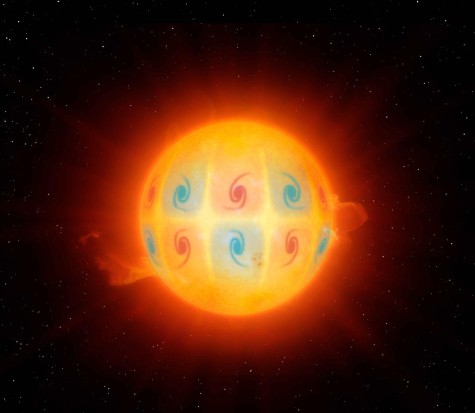NYU researchers discover sun waves that challenge known physics
A research team at NYU Abu Dhabi’s Center for Space Science is conducting an investigation into the origins of high-frequency sun waves after unintentionally discovering them.
NYU Abu Dhabi researchers Katepalli Sreenivasan, Christopher Hanson and Shravan Hanasoge. (Photos courtesy of Katepalli Sreenivasan, Christopher Hanson and Shravan Hanasoge)
April 8, 2022
Researchers at NYU Abu Dhabi’s Center for Space Science discovered a set of high-frequency sun waves that defy previous understandings of physics, traveling much faster than formerly predicted. The researchers — Chris Hanson, Shravan Hanasoge and Katepalli Sreenivasan — conducted their investigation in collaboration with the Tata Institute of Fundamental Research using NYU’s resources.
“This is among several results that we obtained by research in NYU Abu Dhabi, and reflects the high level of research that goes on there,” Sreenivasan, the principal investigator, said. “The undetermined nature so far of these waves promises novel physics and fresh insight into solar and stellar dynamics.”

The investigators were initially looking for large convective cells in the sun —which have a similar appearance to the sun waves — and thought they had found them. After analyzing the data more closely, they realized the waves were acting in a way that is impossible for convection cells. Sreenivasan said that the research team used a technique known as mode coupling to examine the rhythms and structure of the sun.
“We were trying to resolve the convection conundrum, but we happened to find these waves,” Hanson, a research associate and co-author of the study, said. “The convection conundrum still exists. The next step will be to develop computational models. As we start to add more and more physics to the model, hopefully, these waves appear.”
Hanson said there is still no explanation for the waves, but the findings eliminated a number of possible reasons for their existence, including magnetism, gravity and convection.
“We said it can’t be one of these three, but it’s hard to imagine a world where these three aren’t playing some role,” Hanson said. “In my mind, it’s probably a combination of a number of different physics that’s carrying the sun, but apart from that, myself and my co-authors don’t really have a clear idea about what causes these waves.”
The discovery has since sparked discussion over the origins of the phenomenon. Professors at NYU’s Center for Cosmology and Particle Physics in New York have proposed a way to explain the existence of the waves.
“My own immediate thought would be to try tweaking that solar model, and these other aspects, not just the sound waves, and then see how it would feed through to changing their calculations,” Glennys Farrar, a CAS physics professor, said.
Hanson said the research team now intends to look further into their discovery to determine an official conclusion. They plan to start developing computational models to investigate the larger implications of the waves in physics.
“If these waves occur in our sun, it’s likely they occur in other stars as well,” Hanson said. “If we can understand what they are, we can understand their role in our sun and other stars. Observations can only get you so far — you have to start modeling.”
Contact Nicole Lu at [email protected].
























































































































































